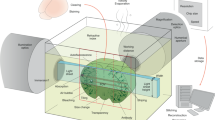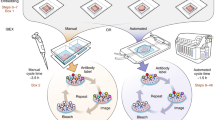Summary
Dye pairs of contrasting colours were selected from acid dyes of varied chemical characteristics. The 44 dye pairs were investigated in a one-bath trichrome staining system in which the dye-baths were strongly acid. Dye concentrations, concentration ratios and staining times were varied for each dye pair. Thirty dye pairs stained collagen fibres distinctly different colours to muscle cytoplasm, while 14 dye pairs gave muddy, non-selective staining. Comparison of dye structures showed that in selective pairs the larger dye always stained the collagen fibres, with cytoplasm being coloured by the smaller species. With 28/30 of the selective dye pairs the differences in anionic weights of the dyes was > 200. However, in dye pairs giving non-selective staining, the anionic weights of the members of 13/14 of the dye pairs differed by < 200. As no other structural feature correlated so clearly with selectivity, it was concluded that the selectivity of one-bath trichromes is diffusion-rate controlled, involving the interaction of differentially permeable tissue sites (collagen being more permeable than muscle cytoplasm) with dyes diffusing at different rates (large dyes slower than small). In keeping with this, lengthening staining times reduced staining selectivity. The rate control mechanism suggested a rational trouble-shooting guide for one-bath trichromes, encompassing such practical factors as dye concentration, embedding medium, fixative, dye-bath pH, section thickness and staining time.
Similar content being viewed by others
References
BAKER, J. R. (1958)Principles of Biological Microtechnique. London: Methuen.
COATS, E. (1969) Aggregation of dyes in aqueous solutions.J. Soc. Dyers Col. 85, 355–68.
CURTIS, D. & HOROBIN, R. W. (1982) Chromosome banding: specification of structural features of dyes giving rise to G-banding.Histochem. J. 14, 911–28.
GILES, C. H. (1975) Dye-fibre bonds. InThe theory of Colouration of Textiles (edited by BIRD, C. L. & BOSTON, W. S.) Bradford: The Dyers Company Publication Trust.
GOLDSTEIN, D. J. (1963) An approach to the thermodynamics of histological dyeing, illustrated by experiments with Azur A.Quart J. micro. Sci. 104, 413–39.
GOMORI, G. (1950) A rapid one-step trichrome stain.Amer. J. clin. Path. 20, 661–4.
GUSTAVSON, K. H. (1949) Some protein-chemical aspects of tanning processes.Adv. Protein Chem. 5, 353–421.
HOROBIN, R. W. (1974) A preliminary quantitative study of the ‘rate of staining’ model for rationalising various mixed acid dye stains (‘trichromes’).Proc. Roy. Microsc. Soc. 9, 1–10.
HOROBIN, R. W. (1980) Structure-staining relationships in histochemistry and biological staining. I. Theoretical background and a general account of correlation of histochemical staining with the chemical structure of the reagents used.J. Microsc. 119, 345–55.
HOROBIN, R. W. (1982)Histochemistry: an Explanatory Outline of Histochemistry and Biological Staining. Stuttgart: Fischer and London: Butterworths.
HOROBIN, R. W. (1983) Staining plastic sections: a review of problems, explanations and possible solutions.J. Microsc. 131, 173–86.
LILLIE, R. D. (1977)Conn's Biological Stains, 9th ed. Williams and Wilkins, Baltimore.
LILLIE, R. D. & FULMER, H. M. (1976)Histopathological Technic and Practical Histochemistry, 4th Edn. New York: McGraw-Hill.
MANN, G. (1902)Physiological Histology. Methods and Theory. Oxford: Oxford University Press.
SWEAT, F., MELOAN, S. N. & PUCHTLER, H. (1968) A modified one-step trichrome stain for demonstration of fine connective tissue fibres.Stain Technol. 43, 227–31.
Author information
Authors and Affiliations
Rights and permissions
About this article
Cite this article
Horobin, R.W., Flemming, L. One-bath trichrome staining: Investigation of a general mechanism based on a structure-staining correlation analysis. Histochem J 20, 29–34 (1988). https://doi.org/10.1007/BF01745966
Received:
Revised:
Issue Date:
DOI: https://doi.org/10.1007/BF01745966




